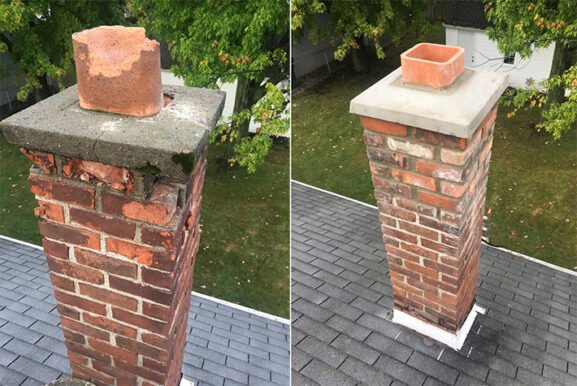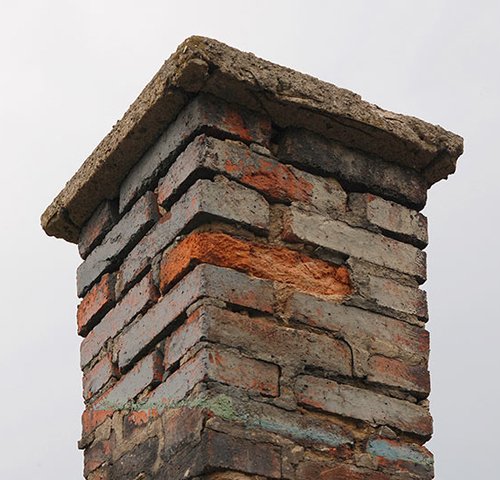Why Homeowners Should Act Now on Chimney Spalling Repair Cost Worries
Key Takeaways
- Chimney spalling is more than a cosmetic problem—it can signal serious structural issues if ignored.
- Repair costs vary depending on the severity, chimney height, brick type, and accessibility.
- Preventive maintenance is the most cost-effective way to reduce long-term repair expenses.
- Early detection and timely intervention help homeowners avoid full chimney rebuilds.
Understanding What Chimney Spalling Really Means
Chimney spalling occurs when the surface of the bricks or mortar begins to flake, crack, or fall off. This damage is often caused by repeated freeze-thaw cycles, where moisture enters the masonry and expands as it freezes. Over time, this expansion breaks down the brick’s surface layer. Spalling not only weakens your chimney’s structure but also opens the door for further water intrusion and heat inefficiencies.
You’ll usually notice the early signs of spalling as chips or flakes on the ground near your chimney or bulging bricks on the chimney face. While this might seem like a small cosmetic issue, it’s a red flag that your chimney’s integrity is at risk. If untreated, chimney spalling can escalate to partial collapse or demand an expensive full rebuild.
What Influences the Cost of Chimney Spalling Repair
Extent of the Damage
The more widespread the spalling, the more labor and materials are needed. Small-scale repairs, such as replacing a few bricks and repointing the mortar, typically range from $300 to $800. However, moderate to severe damage requiring partial rebuilding or reinforcing the chimney stack can cost between $1,000 and $3,000. In the most serious cases, a full chimney rebuild may be necessary, which can exceed $5,000.
Chimney Height and Accessibility
Taller chimneys or those located on multi-story homes are harder to reach, increasing labor time and safety requirements. Contractors may need scaffolding or lifts, which adds to the overall repair cost. Chimneys close to roof edges or those built with intricate designs or materials also demand more precision during restoration.
Type of Brick and Mortar
Matching new bricks with the existing structure ensures visual consistency and performance. If your chimney was originally built with older or custom bricks, sourcing replacements may be more expensive. Similarly, lime-based mortar used in historical homes may require special mixes and skilled masons, further influencing the price.
Local Labor Rates
Labor costs differ based on your region. Urban areas with high living costs often see higher contractor fees. For example, homeowners in New Jersey or New York can expect to pay more per hour for skilled masonry services compared to rural regions. To get a realistic picture of local pricing, consulting with a licensed chimney specialist in your area is essential.
Repair Methods Used by Professionals
Brick Replacement and Tuckpointing
This is the most common solution for mild to moderate spalling. The damaged bricks are removed and replaced with new ones. Tuckpointing then follows to reinforce the mortar joints and restore structural integrity. This is a highly effective method to preserve the chimney without a complete overhaul.
Application of Waterproof Sealants
After physical repairs, many contractors apply a breathable waterproof sealant to the chimney. This helps repel moisture while still allowing trapped water to escape, preventing future spalling. It’s important to avoid generic sealants, which can trap moisture and accelerate damage.
Use of Chimney Caps and Flashing Repair
A proper chimney cap and flashing system help keep water from seeping into the brickwork. If these components are missing or deteriorating, they will need to be repaired or replaced during the spalling repair process. These additions typically cost less than $500 and offer a strong defense against future water-related issues.
Why Early Action Helps You Save More
Addressing chimney spalling as soon as it’s noticed can significantly reduce long-term costs. Minor cracks caught early might only need simple patching, costing a few hundred dollars. Delaying repairs can allow water to penetrate deeper into the chimney, compromising both its function and safety.
Moreover, homeowners who regularly inspect and maintain their chimneys tend to spend significantly less over the chimney’s lifespan. According to the National Association of Home Builders, masonry components that are regularly maintained can last over 100 years. Preventive care extends your chimney’s lifespan and keeps heating systems running efficiently.
Estimating Costs Without a Contractor Visit
For homeowners trying to budget in advance, basic price ranges can help. Here’s a general breakdown based on typical repair types:
| Type of Repair | Estimated Cost |
| Minor tuckpointing (under 10 sq ft) | $300 – $500 |
| Brick replacement (small section) | $600 – $1,000 |
| Full chimney face repair | $1,500 – $3,000 |
| Complete chimney rebuild | $5,000+ |
These are rough estimates and vary depending on chimney material, labor rates, and accessibility. A professional inspection will provide the most accurate assessment of your chimney’s condition and the cost to fix it.
How Climate and Seasonal Changes Add to Repair Costs
In cold climates like the Northeast, freeze-thaw cycles are particularly harsh on chimneys. Moisture seeps into even tiny cracks, freezes, and expands—worsening existing damage. This repeated stress accelerates spalling. Spring and fall are the ideal times for repair, as temperatures are moderate and mortar has time to cure properly.
If repairs are delayed until winter, you may face increased labor costs and weather-related complications that slow progress or require temporary solutions. Scheduling repairs during mild seasons is both cost-effective and safer for workers.
Long-Term Care Strategies That Keep Chimney Repair Costs Down
Regular chimney maintenance reduces the risk of costly repairs. Annual inspections by certified chimney sweeps can catch minor damage before it escalates. Installing or upgrading a chimney cap, ensuring flashing is intact, and sealing your bricks with professional-grade water repellents are all practical ways to guard against spalling.
It’s also wise to monitor the surrounding roof and gutter system. Water runoff from clogged gutters or poorly designed rooflines can channel water directly onto your chimney, increasing spalling risks.
When It’s Time to Rebuild Not Just Repair
There are situations where patchwork repairs simply won’t cut it. If large sections of the chimney are deteriorating, or if interior flue tiles are damaged, your best option may be a full chimney rebuild. Although this is a more expensive upfront cost, it guarantees long-term safety and functionality.
Rebuilds also offer a chance to upgrade materials for better moisture resistance, such as switching to hard-fired clay bricks or adding advanced liners. While it’s a larger investment, it protects the value of your home and ensures heating appliances operate safely.
Making the Right Call for Your Chimney’s Future
Spalling damage is a warning sign that shouldn’t be ignored. Whether your repair is small or extensive, acting quickly can save you from higher expenses down the line. Getting a professional assessment and investing in quality workmanship now helps you avoid full-scale reconstruction later. Protecting your chimney means protecting your home’s structural health, comfort, and long-term value.

